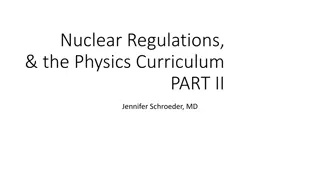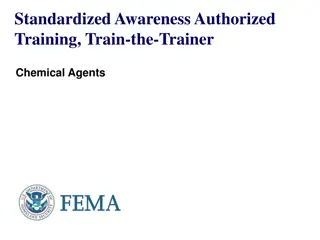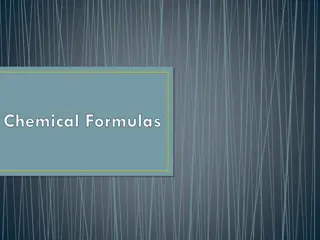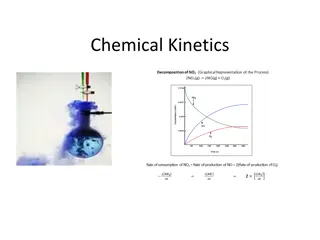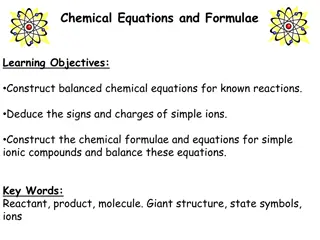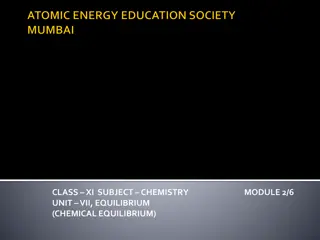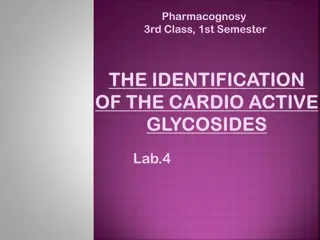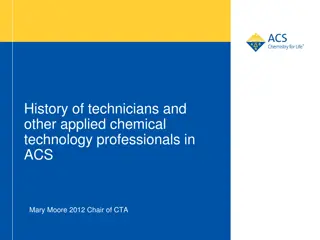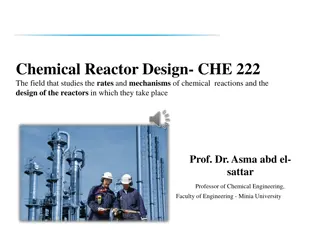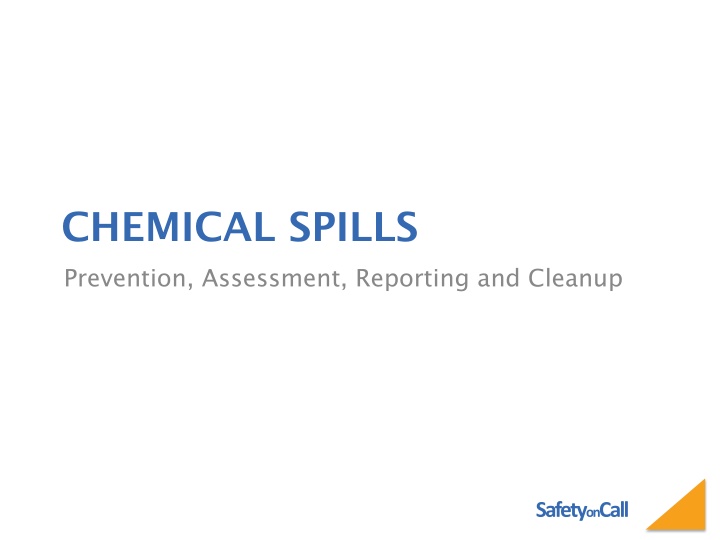
Chemical Spill Prevention, Assessment, Reporting, and Cleanup Safety Guide
Learn about OSHA and EPA regulations for chemical spill cleanup, responsibilities, prevention strategies, and how to handle nuisance and hazardous spills. Understand the importance of proper preparation to ensure safety in case of spills.
Download Presentation

Please find below an Image/Link to download the presentation.
The content on the website is provided AS IS for your information and personal use only. It may not be sold, licensed, or shared on other websites without obtaining consent from the author. If you encounter any issues during the download, it is possible that the publisher has removed the file from their server.
You are allowed to download the files provided on this website for personal or commercial use, subject to the condition that they are used lawfully. All files are the property of their respective owners.
The content on the website is provided AS IS for your information and personal use only. It may not be sold, licensed, or shared on other websites without obtaining consent from the author.
E N D
Presentation Transcript
CHEMICAL SPILLS Prevention, Assessment, Reporting and Cleanup SafetyonCall
OBJECTIVES Create Awareness of State and Federal OSHA & EPA regulations that affect spill clean-up. Explain responsibilities. Provide strategies to prevent spills: Assess hazards presented by spills. Report spills when needed. Clean-up spills when appropriate. SafetyonCall
REGULATIONS OSHA 1910.120 - Hazardous Waste Operations and Emergency Response. Very specific training and procedures are mandatory for reporting of and response to chemical spills that are considered HazMat incidents. A HazMat spill is one where there is an immediate danger to life and health. Most dock spills are not HazMat incidents. Numerous EPA regulations control hazardous waste. SafetyonCall
RESPONSIBILITIES Employees are responsible for: Ensuring spills are reported or cleaned up in a timely manner. Cleaning up nuisance spills of materials in their area, even if someone else spills them(janitors, service people). Knowing the properties of the materials they are working with. Taking reasonable steps to prevent spills. HazMat team will: Clean-up serious (HazMat) spills. SafetyonCall
NUISANCE SPILLS Spills of: Less than 2 gal. of material that you know the Hazards of and are comfortable cleaning up: o Assess the hazard. o Wear appropriate PPE. o If you are unsure of the hazard of a spill or need assistance with PPE selection call Safety. SafetyonCall
POTENTIALLY HAZARDOUS SPILLS Spills of: Greater than 4 gallons. Smaller spills of materials of: o Low LD50 o Carcinogens o Flammable liquids or metals o Compounds of unknown toxicity SafetyonCall
PREVENTING SPILLS Eliminate clutter. Know proper work practices for chemical materials you use. Use unbreakable secondary containers. Store chemicals properly. Dispose of waste and excess chemicals in a timely manner. SafetyonCall
PREPARATION What are the physical and toxicological properties of the chemical materials you use? What is the worst thing that could happen if you dropped/spilled a bottle of each chemical you use? Inconvenience Skin burns Fire Chemical exposure ( fatality? permanent injury?) SafetyonCall
HAZARDS Toxic Flammable Caustic Reactive/Explosive Radioactive Other? SafetyonCall
YOU ARE THE EXPERT ON THE HAZARDS OF MATERIALS IN YOUR POSSESSION. Know properties of chemicals you use before you handle them. Know what appropriate work practices are & use them. Know what the worst case scenario is for a spill of the chemicals you use. Think about how you will react to a spill of the materials you use. Know what appropriate clean-up procedures are for the materials you use. SafetyonCall
TOXIC MATERIALS Assessing the risks due to the toxic effects of chemicals: Route of exposure Acute Toxicants Corrosive Substances, Irritants and Allergens Carcinogens Infectious materials SafetyonCall
EXAMPLES OF MATERIALS WITH A HIGH LEVEL OF ACUTE TOXICITY Acrolein Diazomethane Hydrogen cyanide Hydrogen fluoride Biological toxins; Tetrodotoxin, snake venoms SafetyonCall
TOXICITY OF COMMONLY USED CHEMICALS Chemical OralLD50 (rat, mg/kg) Skin LC50 (rabbit) no data Inhalation LD50 (rat, ppm 1/ hr) 50100 8 hr Acetone Acetone 5800 Acetonitrile Acetonitrile 2460 982.5 7551 8hr Moderately toxic by skin absorption Acrylamide Acrylamide 124 400 NA Moderately toxic by ingestion, skin absorption. OSHA Carcinogen Methanol Methanol 5628 15800 6400 4 hr Methyl Isocyanate Methyl Isocyanate 51.5 6.1 6 hr 220 Acutely toxic by skin abs, ingestion Tetrodotoxin Tetrodotoxin 3.8X10- 3mg/kg no data no data One of the most toxic substances known to man SafetyonCall
FLAMMABILITY HAZARDS Location, location, location Ignition sources Ventilation Other fuels in the area Don t store more than 10 gallons of flammable liquids outside of flammable liquid storage cabinets. SafetyonCall
FLASH POINT - THE LOWEST TEMPERATURE AT WHICH A LIQUID HAS SUFFICIENT VAPOR PRESSURE TO FORM AN IGNITABLE MIXTURE WITH AIR NEAR THE SURFACE OF THE LIQUID Chemical Acetone Flash Point -2.2 F Acetone Acetonitrile Acetonitrile 42.0 F Methanol Methanol 51.8 F Diethyl Ether Diethyl Ether - 54.0 F Gasoline Gasoline - 45.0 F SafetyonCall
CAUSTIC CHEMICAL HAZARDS Acids & Bases (organic and inorganic) ex. : HCl, Permanent eye damage. Skin burns Inhalation hazards Know the differences in hazards between concentrated vs. dilute solutions. SafetyonCall
CHEMICAL SPILL RESPONSE NUISANCE SPILL Alert people in immediate area of spill. Wear appropriate protective gloves, goggles, apron. Avoid breathing vapors from the spill. Confine spill to small area& absorb on absorbent pads &/or kitty litter. Clean spill area with soap & water. Collect all contaminated absorbent, gloves & residues in plastic bag lined garbage can. Label and dispose of properly (call Environmental). SafetyonCall
CHEMICAL SPILL RESPONSE POTENTIALLY HAZARDOUS SPILL Attend to injured or contaminated persons and remove them from the exposure if you can do so without endangering yourself. Alert persons in the immediate area to evacuate. If spilled material is flammable, turn off heat and ignition sources. Call Spill Emergency contractor. Close doors to affected area. Have a person knowledgeable of incident assist HazMat personnel. SafetyonCall
ESTIMATING POTENTIAL HAZARDS Research hazards before you use a new chemical. Consider the toxicity, flammability, physical state and the amount of the material involved. Consider the location of the spill. Consider your knowledge and skills. Ask for help in estimating hazards call Safety. SafetyonCall
SUMMARY Know the properties of all the hazardous materials you handle Prevent spills If a potentially hazardous spill occurs, protect people first, evacuate & ask for help Call for EMERGENCY spill/fire assistance Call Safety for information and non-emergency assistance You are responsible for reporting or cleaning up spills of materials you use SafetyonCall



